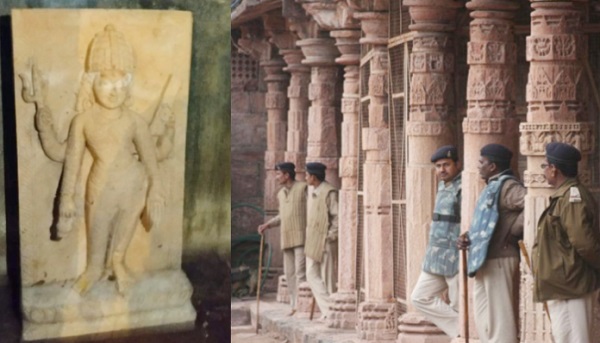Paromita Das
GG News Bureau
New Delhi, 30th April. The Archaeological Survey of India (ASI) has been surveying Bhojshala, or Maa Vagdevi (Saraswati Temple), at Dhar, Madhya Pradesh, for the past 37 days. It appears that every fresh finding points to the possibility that there was once a vast Sanatan educational hub with Goddess Saraswati as its patroness here in history. Although the Muslim community frequently refers to this location as Kamal Maulana Masjid, the ASI team has so far discovered a wealth of evidence sufficient to demonstrate that it is a Hindu temple.
Upon conducting a survey on both the north and south sides of the Bhojshala behind it, the ASI discovered three walls that seemed to be descending during work done inside the Bhojshala during the excavation in front of the sanctum sanctorum. One wall runs from north to south, and two walls go east to west. Which ASI is presently conducting extensive research on. In the process of clearing dirt from the rear, a piece of the damaged statue was discovered today. Subsequently, Gopal Sharma asserted on behalf of the Hindu side that the Sanatan Dharma-described form of idol worship—the area above the statue’s shoulder—had been discovered.
Bhojshala was formerly known as Sharda Sadan, Saraswati Kanthabharan
According to him, the statue depicts the tale of the Islamic invaders who attempted to wipe out a highly developed civilization in Bhojshala. Saraswati Kanthabharan and Sharda Sadan were the previous names of this dinner hall. Gopal Sharma said that following this survey, it will reclaim its pride. He added that worship had been discontinued here after an attack by Alauddin Khilji in 1305, but that it had been restored on April 8, 2003, following a protracted legal battle. No, that has not yet been acquired based on archeological data.
Notably, five of the eight locations in the inner complex that the ASI team chose to remove soil were completed. Aside from this, the crew has so far examined the Havan Kund located on the Bhojshala property. Members of the team have also surveyed the roof of the Akal Kuiyan neighborhood of Bhojshala. Both inside and outside the banquet hall, soil samples have been collected by the investigative team. To determine the precise age of the Bhojshala, samples of the stones that were unearthed have been collected. There are carbon dating sites nearby. Access to the foundation excavation is via stairs. In addition to excavation, the site is being used for other purposes, such as carbon dating, GPS, and radar (GPR).
The Supreme Court did not provide any form of relief to the Muslim side
During the survey, photos and video are also employed. In addition, marking was carried out up to Kamal Maula Mosque, outside of Bhojshala. Outside the banquet hall, in front of the cemetery, there was additional marking done. There are measurements taken of the banquet hall’s roof as well. On the other hand, the Muslim side has petitioned the Supreme Court through Maulana Kamaluddin Welfare Society to halt ASI’s survey operations. A request to stay the Madhya Pradesh High Court’s Indore Bench’s survey-related ruling was made in the plea. But the Supreme Court was unable to provide him with remedy. Actually, the High Court received a plea for a scientific survey of the Bhojshala complex from Hindu Front for Justice. After learning of this, the High Court’s Indore Bench has directed the ASI to carry out a scientific investigation which the Muslim side had petitioned the Supreme Court to overturn.
On the pillars are statues of the gatekeepers Jai-Vijay, Varaha, Ram, Lakshman, and Sita
Advocate Alok Kumar, the National President of the Vishwa Hindu Parishad, states that the situation in Bhojshala is unique compared to other regions. Every Tuesday, Hanuman Chalisa and puja are done in addition to the weekly namaz. The Monuments Act of 1904 led to the designation of this location as protected. Later on, such protection was reaffirmed as well. This location is now ASI. possesses authority over. Muslims never held the power to dominate it.
They claim that although the Bhojshala temple was referenced in these income documents prior to 1935, it was never identified as a mosque. Before 1935, Namaz was never presented here either. The Places of Worship Act exempts any location that is not designated as an archeological monument. It doesn’t come in that either because of this. What is the fundamental nature of it? On the pillars are statues of Varaha, Ram, Lakshman, and Sita. The idol of the gatekeepers is Jai-Vijay. Aside from this, the land’s internal feelings are being thoroughly examined.
Bojshala was destroyed in 1456 by Mahmood Khilji
In addition, a lot of historians think that in 1034 Raja Bhoj founded a college in Dhar called Bhojshala, which was called Saraswati Sadan. It was invaded in 1456 by Mahmood Khilji, who destroyed the Bhojshala and erected a building on its ruins. Built in the 11th century, it is known by Muslims as the “Kamal Maula Mosque”. On the other hand, the pillars that support the purported mosque are the same ones that Raja Bhoj originally had constructed for the Bhojshala. Two Prakrit-language phrases regarding Lord Vishnu’s Kurma avatar are inscribed on stones that are affixed to the building’s walls as evidence of this. Another inscription has information about Sanskrit grammar. Aside from this, certain inscriptions directly honor King Bhoj’s successors, Udayaditya and Naravarman.
In 1902, Lord Curzon dispatched the Mother Saraswati idol to England.
It is also historical truth that Muslim dominance in Malwa came to an end in 1703 AD when the Marathas acquired control of the region. Subsequently, in 1826 AD, the East India Company seized authority over this Malwa province. They also launched an attack on Bhojshala, a historical site. The British carried out the task of demolishing numerous temples and monuments during that era. In 1902, Lord Curzon removed the goddess’ idol from Bhojshala and transferred it to England. This statue is still on display in a London museum.

